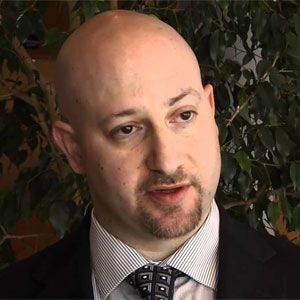Lu-Dotatate Continues to Offer Major Benefits to Patients With Midgut NETs
Patients with advanced midgut neuroendocrine tumors (NETs) will continue to see major therapeutic benefits from the peptide receptor radionuclide therapy Lu-Dotatate (Lutathera), including an improvement in overall survival and the reduction of progression or death risk by 79%.
Lu-Dotatate Midgut NETs

Jonathan R. Strosberg, MD
Patients with advanced midgut neuroendocrine tumors (NETs) will continue to see major therapeutic benefits from the peptide receptor radionuclide therapy Lu-Dotatate (177Lutetium DOTATATE; Lutathera), including an improvement in overall survival and the reduction of progression or death risk by 79%.
The update of Lu-Dotatate's efficacy comes from the randomized phase III NETTER-1 trial, which also showed that the therapy was “quite well-tolerated,” according to lead author Jonathan R. Strosberg, MD, medical oncologist, Moffitt Cancer Center. Strosberg presented the results during a presscast at the 2016 Gastrointestinal (GI) Cancers Symposium to be held between January 21 and 23 in San Francisco, California.
Lu-Dotatate represents the latest generation of peptide receptor radionuclide therapy (PRRT) treatments, whereby a radioactive isotope is attached to a somatostatin analog in order to better target its radiation to tumors expressing the somatostatin receptors. These receptors are present in most highly differentiated neuroendocrine tumors.
Earlier iterations of the therapy have been studied widely in Europe, where it has delivered promising results in early-phase trials and where a pathway exists for hospitals to produce their own radiopharmaceuticals to administer to their patients, an option not currently available in the United States.
The international NETTER-1 trial involved 229 patients with inoperable, somatostatin receptor-positive NETs in the small intestine and proximal colon, which is the most common primary site for advanced NETs. The patients had all progressed on standard-dose somatostatin analog (SSA) therapy. They were evenly randomized to either 4 administrations of 7.4 GBq of Lu-Dotatate every 8 weeks or a control arm receiving high-dose octreotide LAR (60 mg, every 4 weeks), equivalent to twice the standard 30-mg dose. After their PRRT treatment ended, patients in the experimental arm continued on a standard-dose SSA until progression.
The trial’s primary endpoint of progression-free survival (PFS) was assessed every 12 weeks based on RECIST criteria and met in an “extremely impressive fashion,” said Strosberg. Twenty-three progressions or deaths occurred with Lu-Dotatate, compared with 67 events in the control arm (HR, 0.21;P<.0001).
Median PFS in the control arm was 8.4 months, but it has not yet been reached in the Lu-Dotatate arm. “In fact, in the roughly year-and-a-half duration of follow-up thus far, we can see that the expected median PFS is likely to be longer than 3 years,” Strosberg predicted.
One complete response was reported with Lu-Dotatate and 17 partial responses. There were no complete responses in the control arm and only 3 partial responses, translating into an objective response rate of 18% with Lu-Dotatate versus 3% with the SSA octreotide LAR (P= .0008).
“This is a population of patients with midgut neuroendocrine tumors that has been highly resistant to systemic treatments, at least as far as response rate is concerned,” Strosberg pointed out, with most response rates being in the single digits in the early studies. “This is the only study to show a double-digit objective response rate in this population.”
Final overall survival (OS) data are expected next year, but based after an interim OS analysis, 22 deaths occurred in the control arm versus 13 with Lu-Dotatate (P= .0186.) Strosberg said that though this is not a statistically significant finding at this point, “it is certainly suggestive of improvement in overall survival.”
The findings being presented at the GI Cancers Symposium feature additional safety data from NETTER-1, Strosberg explained. The trial results also were presented last fall at the 2015 European Cancer Congress and the 2015 NANETS Symposium.
Overall, the numbers of adverse events (AEs), including serious side effects, were similar between the two treatment groups. Nausea (all grade) was reported in 59% of patients in the Lu-Dotatate arm versus 12% with controls, and vomiting occurred in 47% and 10% of patients, respectively. Strosberg suggested that most of these GI side effects were related to the amino acid infusions that were used as nephroprotective drugs in combination with the Lu-Dotatate.
The trial mandated commercial formulations of these agents, which Strosberg said are quite nauseating, adding that in Europe, modified amino acid formulations are used that are much less so. “The nausea and vomiting typically resolved once the amino acid was discontinued, and the duration of infusion is roughly 4 to 6 hours,” he said.
“The safety profile with Lutathera appears to be quite favorable, with no clinically relevant findings, particularly with respect to the main concerns, which are hematologic, renal, and hepatic parameters.”
Smitha Krishnamurthi, MD, ASCO spokesperson and presscast moderator, agreed on the potential of this therapeutic approach to treat tumors that are typically unresponsive to systemic therapy:
“This tumor-targeted peptide receptor radionuclide therapy represents a new modality of anticancer treatment,” she said. “It’s exciting to see a novel therapy have such a significant effect on tumor growth, particular for these patients who have limited treatment options.”
References
- Strosberg JR, Wolin EM, Chasen B, et al. NETTER-1 phase III: Progression-free survival, radiographic response, and preliminary overall survival results in patients with midgut neuroendocrine tumors treated with 177-LU-Dotatate.J Clin Oncol34, 2016 (suppl 4S; abstr 194).